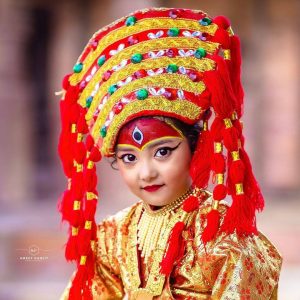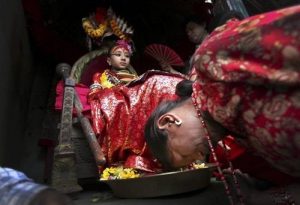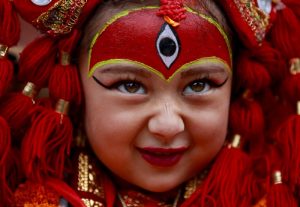Nepalese worships a normal young girl as Kumari, the only living deity (goddess) in the world, turning her into a Goddess of Power with tantrism and different rituals.

A young goddess Kumari in her royal attire | Photo by Ameet Ranjit
Nepal is rich in culture and traditions. If you visit Nepal, you witness a unique tradition of worshipping a young prepubescent girl as a living goddess, Kumari. The literal translation of Kumari is virgin. But here, “Kumari” is taken from the Sanskrit word “Kaumarya” which translates to “Princess”.
Buddhists consider the little divine being as the personification of the supreme female deity Vajradevi, a Buddha. In Hinduism, the young princess is considered a manifestation of Devi (Taleju Goddess) and is worshipped with great devotion in different places in Nepal. It’s a unique tradition where a young normal girl is chosen and is turned into a living deity using different tantric and pujas. Hindus believe she protects the nation from evil with her Goddess power of Taleju (one reincarnation of Goddess Durga). So, watching the goddess Kumari is one of the best things to do in Kathmandu.
While selecting, priests choose the eligible child from the Buddhist community to be made the living goddess of a Hindu community. This cross-religious practice sets an example of religious harmony.
There are 10 Kumaris in Kathmandu Valley. While there are many living goddesses in Nepal, the girl living in the Kumari Ghar, a palace in the center of Kathmandu, is the Royal Kumari of Nepal.
The current Royal Kumari of Nepal is Trishna Shakya. She was selected as a living goddess of Nepal in 2017 when she was 3 years old. She lives inside the premises of Kathmandu Durbar Square, and people consider her to be the supreme of all.
How and when did the Kumari Puja tradition start?
You can get to read various tales of Kumari Puja in Nepal. The famous and most believed tale is of Jay Prakash Malla, an ancient Malla king in Nepal. People say that the king used to play dice games with goddess Taleju in his chamber. Taleju was the clan deity of the Mallas. So, neither anyone should know nor he could tell. Unfortunately, one day, his queen found them playing dice in his chamber.
Being caught by the queen, the goddess Taleju disappeared. Before leaving, the Taleju goddess told the king that she will incarnate herself as a little girl of the Newari (Shakya) community of Ratnawali. After hearing her statements, the King left the palace in search of a young girl possessed by Taleju’s spirit. This way, the tradition of worshipping the young girl started around the 17th century in the Kathmandu valley.
While some also believe that the king was Trilokya Malla instead of Jay Prakash Malla. One day, while playing, he tried to approach the deity with sexual intentions. As soon as the deity caught his actions, she disappeared. Later, the king cried in regret and pleaded to never do it again. Seeing the king cry, the goddess agreed to appear in the body of a Kumari, a young girl from the Shakya family. This is how the Kumari tradition started in Nepal.
Although there are different tales about the start of the tradition, there are no actual findings of why and when did it start. These are just people’s beliefs and don’t have any pieces of evidence of the past.
How is the young girl selected as a Living Deity, Kumari, in Nepal?
Selecting Kumari is intense. The selection process is almost identical to choosing the Dalai Lama or Panchen Lama of Tibet. Five senior Buddhist Bajracharya priests conduct the selection process, including the Taleju Bhawani chief priest, the Kumari house caretaker, and the head astrologer. They check on the various aspects of a child before declaring her a new living goddess.
First, she must come from a Shakya family. However, other Kumaris in the valley, except for the royal Kumari, may also include a girl from the Bajracharya family. The members, including all three generations of her, should be within the same caste as well. Other basic requirements include sound health and uncut and blemished body skin. She shouldn’t have shed a single drop of blood prior.
Also, she must lose none of her teeth. Once she meets the basic requirements, the priests examine her to match Battis Lakshana’s. Battis Lakshana is 32 perfections of goddesses in the Hindu religion. Some perfections are from her physical appearance which includes a chest like a lion, thighs like deer, and the eyelashes like a cow.
Further, they look at her horoscope to make it complementary to that of the king’s or president’s horoscope. If she meets every quality, they take her to another test. In this, she has to walk through a courtyard filled with beheaded animals, and dancing mask men. She should cross the courtyard without being afraid. Here, if she looks scared, she is disqualified. Again, if she qualifies through all of her previous tests, they take her for the ultimate test. In this, she should spend a night alone in a room with the ritually slaughtered goats and buffalos.
Some also believe that being kept in a room of slaughtered animals and should be able to walk through the beheaded animals is not 100% true. Nobody actually knows what happens inside the room. Also, the Kumaris themselves are too small to remember her selection process. The room part is hidden and only the priests know about it. However, many believe that she is the embodiment of blood-loving Durga so, she is only shown some animal blood by the masked men to check how she reacts.
Finally, completing all of her previous tasks, which also include staying in that hidden room, she is now asked to pick up the belongings of the previous goddess. If she picks them correctly among other goods, she is the new living goddess of Nepal.
The selection process for the new living deity should be completed before late October. After being selected, she is sanctified and the priests perform various tantric rituals to cleanse her body of impurities and blemishes. Then, the goddess Taleju is believed to enter her. They now present the girl as the Goddess Kumari and shift her to Kumari Ghar.
Only the Royal Kumari is shifted to Durbar square while others living in the valley live at their own home following some sort of rituals. They remain the living goddess for the duration of their divinity, which is until they bleed. Bleeding is the commencement of the first menstrual cycle. After the first mensuration, the selectors select a new living female deity based on the above prerequisites. Sometimes, they also lose the title when they suffer a cut and lose blood.
She lives inside Kumari Ghar. People wait for a long time outside the window of that palace in a hope that they can see a glimpse of the living deity. People believe just a glimpse of the living deity will bring good fortune. It is also believed that Kumari holds special power over the illness. Many high-profile people visit her to receive blessings and good fortune.
When someone visits, her actions are recorded and interpreted to decide the future of the visitor. If she cries or laughs out loud, rubs her eyes, trembles, and picks up the food offerings, the visitor will have bad times, which may be a serious illness, financial loss, or any other bad times.
If you come to Nepal, you may also visit the area to catch sight of the little female deity. She is taken outside only on special occasions, like Indra Jatra.
Indra Jatra is one of the major festival events in Nepal. During Indra Jatra, she is kept inside the chariot, and hundreds of exuberant pull the chariot. Thousands of visitors gather to see her. Even her small glimpse is believed to bring some good fortune. Moreover, the dancing mask men, colorful roads, tuning of local instruments, and a large procession of devotees are a great sight to behold. Visiting Kathmandu in late August or early September will let you witness the celebration.

A woman doing the makeup of Goddess Kumari | Photo by Ameet Ranjit
Walking around the Durbar square after being selected is the last time she steps on the floor for the period of being Kumari. Her caretakers carry her everywhere when she was out of her residence. After the girl becomes Goddess Kumari, her feet are now pure and holy. In the past, even the king used to visit her to touch her feet to receive blessings. People believe that touching her feet will bring good times. Still, when she is out for a while, there will be an immense crowd of people willing to touch her feet.
During their time living as deities, Kumaris from Kathmandu, Bhaktapur, Lalitpur, and Nuwakot receive some money monthly from the government. Further, they also get a small amount as a pension after losing the title of the Living Deity.

A woman bowing down to touch the feet of a living deity to receive blessings. Photo by: NepaliAustralian
Various claims about the child’s rights of Kumari
Various child and human rights activists claim that this tradition violates the rights of Kumari. Since they are separated from their families and deprived of various child rights, activists believe that government should ban this tradition. But this tradition has ancient historical and cultural significance. Therefore, it is now being practiced considering all her rights.
Several years ago, Kumaris were deprived of education because they were considered omniscient. But, nowadays, all others except the Royal Kumari live a normal life. They go to school, play with friends, and everything is normal like the other child from society. The only thing is they have to perform rituals on special occasions where they dress up as a goddess and perform the ritual. There’s also a misconception that the child cannot marry and have kids later. But in reality, she can marry and have a normal life after her first period, during which she is taken back from the title Kumari. It’s now a privilege for being selected as a living deity.
And for the Royal Kumari, receives education through private tutors inside the Kumari Ghar. She also has friends to play with inside her residence. There are even facilities for the Internet, books, papers, etc. They also attend national exams under special supervision. Many things in the past have changed. This way several progressive changes are being made to fulfill her rights and make her live a normal life after resigning from the title, while also keeping the traditions alive.

A young girl dressed as the Living Goddess Kumari takes part in the Kumari Puja festival, in which young girls pose as the Living Goddess Kumari and are worshipped by people in the belief that their children will remain healthy, in Kathmandu, Nepal, September 11, 2019. Photo: Reuters, Himalayan Times

-min.png)